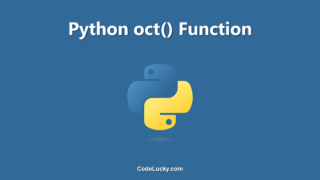The hex() function in Python is a built-in function that converts an integer number to a hexadecimal string representation. The hexadecimal system is a base 16 number system that uses the digits 0-9 and the letters A-F to represent values.
Syntax
hex(number)
Parameters
number – the integer number to be converted to a hexadecimal string
Return Value
The hex() function returns a string representation of the input integer in hexadecimal format.
Examples
Example 1: Convert Integer to Hexadecimal
x = 255 print(hex(x))
Output:
0xff
In this example, the integer number 255 is converted to its hexadecimal representation using the hex() function. The output shows the hexadecimal string 0xff, which represents the decimal value 255 in hexadecimal form.
Example 2: Convert Negative Integer to Hexadecimal
x = -255 print(hex(x))
Output:
-0xff
In this example, the negative integer number -255 is converted to its hexadecimal representation using the hex() function. The output shows the hexadecimal string -0xff, which represents the decimal value -255 in hexadecimal form.
Example 3: Convert Integer to Hexadecimal with Prefix
x = 255
print(hex(x))
print(f"0x{hex(x)[2:]}")
Output:
0xff 0xff
In this example, the integer number 255 is first converted to its hexadecimal representation using the hex() function. The second output shows the same hexadecimal representation but with the prefix 0x added to it, which is commonly used in programming to represent hexadecimal numbers.
Use Cases
The hex() function is often used in programming to convert integer values to hexadecimal strings for display or for use in calculations. For example, in network programming, it is common to work with IP addresses, which are represented in hexadecimal form. The hex() function can be used to convert IP address values to their hexadecimal string representation for display or for use in calculations.
In addition, the hex() function can be used to convert values between different number systems for more convenient representation and easier calculation. For example, converting binary or octal numbers to hexadecimal can make it easier to work with those numbers, especially when dealing with larger numbers that are difficult to represent in binary or octal form.
Another use case of the hex() function is in cryptography and data encryption, where integer values are often converted to hexadecimal strings to be used as keys or to represent encrypted data in a more compact form.
In summary, the hex() function is a versatile and useful tool in various areas of programming, providing an easy and convenient way to convert integer values to hexadecimal string representation for display, calculation, or representation purposes.







